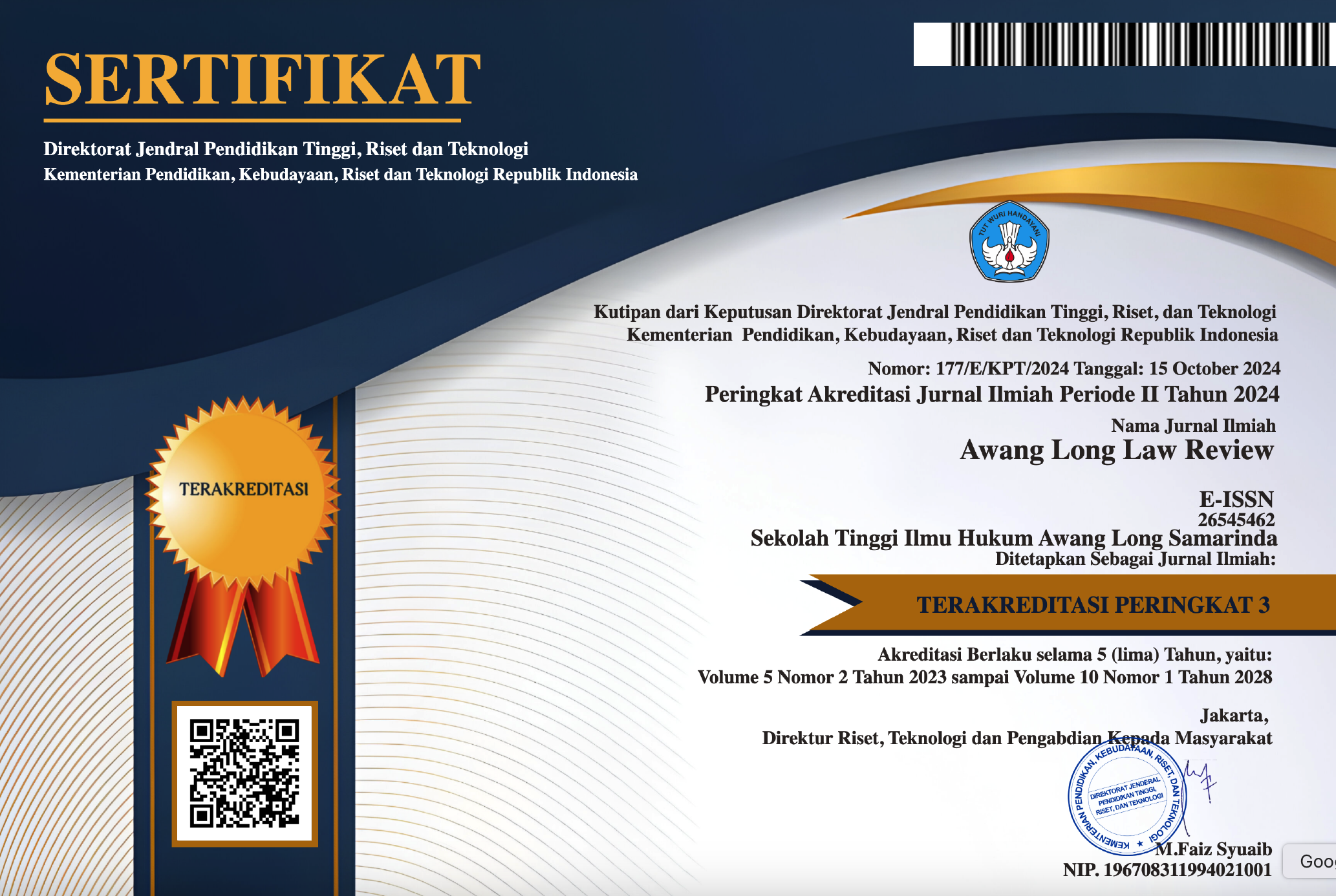AUTHORS SUBMISSION GUIDELINE
AUTHOR GUIDELINES
Submission to this journal proceeds totally online and must be submitted at http://ejournal.stih-awanglong.ac.id/index.php/awl/about/submissions
Please read and follow these instructions carefully. Doing so will ensure that the publication of your manuscript is as speedy and efficient as possible. The Publisher reserves the right to return manuscripts that are not prepared according to these instructions.
Originality of the Article
- The manuscript is written in the format required by the Author Guidelines of the AWANG LONG LAW REVIEW
- The manuscript does not contain plagiarism, falsification and/or fabrication of data.
- The manuscript is not submitted to another publication and is not be under review for publication elsewhere during the AWANG LONG LAW REVIEW review process.
- The manuscript is not accepted for publication elsewhere.
- The submission file is in OpenOffice, Microsoft Word, RTF, or WordPerfect document file format.
Format
The manuscript of the article is written in standard English. Number of pages consists of 15 - 20 (twenty) pages (including figures and tables), and appendices should not be included in the text. Scripts are written in single-space on one side of A4 size paper (210 x 297 mm), two-column form with page setup: margin of 2.5cm; Bottom 2.5 cm; Left 2.25cm and right 2.25cm. The script of the article is written with Times New Roman font size 12pt and the indent for the paragraph is 1cm. The writing style refers to the APA Style (The American Psychological Association).
The manuscript is presented in several sections: Introduction (Introduction contains background issues, motivation research, theory, research objectives written in the form of flowing paragraphs), Literature Review (Include theoretical framework, hyphoteses development), Research Methodology (method, data type, data source, data collection technique, population, sample, variable operationalization, data analysis technique), Results and Discussion, Conclusion & Recomendation, References
Title
The title should be specific, effective and informative as measured by the writing assignment, not exceeding 12 words in English, so it can be comprehensively understood. The font size for the article title is Times New Roman 14pt, with all capital letters, bold and center print
Author
The author's identity contains the name of the author (without title), origin of institution, institution address for correspondence, and author email. Author name (without title) with Times New Roman 12pt, with capital letters at the beginning of each word, bold, and centered. Under the author's name is the origin of the agency, the author's email, with Times New Roman 11pt, and capital letters at the beginning of each word, without bold print.
Abstract
Abstract writing between 100-200 words, italicized in two languages Indonesian and English. Abstract English is written first and then abstract Bahasa Indonesia. Abstract is not a summary consisting of several paragraphs. Abstract content includes research objectives, data / research objects, methods, results, findings or conclusions. 11pt font size.
Keywords:
Key writing or keywords, adjusting to the language in the article. Keywords or keywords are written in Bahasa Indonesia and English. Keywords are carefully selected, accurate and able to reflect the concepts / variables contained in the article five keywords. Written in alphabetical order, between keywords separated by semicolons (;).
INTRODUCTION
Introduction contains background issues, motivation research, theory, research objectives written in the form of flowing paragraphs.
LITERATURE REVIEW
Literature Review contains the grand theory and other theories that are presented in complete, concise sentences. Additionally, it contains relevant reference to relevant prior research contained in the introduction. And explain the development of hypotheses (if any) (without sub-chapters).
RESEARCH METHOD
The research method contains the research design used (method, data type, data source, data collection technique, population, sample, variable operationalization, data analysis technique, written in flowing paragraph form (no numbering).
RESULT AND DISCUSSION
Contains systematic written research results, critical, and informative analysis. The use of tables, drawings, etc. only as a supporter to clarify the discussion and limited only to substantial supporters, such as tables of statistical test results, model test results etc. The discussion of the results is argumentative regarding the relevance of results, theories, previous research and the empirical facts found, and shows the novelty of findings.
Each table is written without a vertical line and comes with a year source of data processing research. The output of a table is manually written in the draft of an article, indicating only the data needed (not directly from the output). Title writing is above the left flat table (11 bold font, space 1), table contents (font 10-11) and the source is below the left flat table (font 11). Table length adjusted to page width. As for images or graphics, clearly displayed and can be read. The title is below the middle flat image (11 bold font, space 1).






